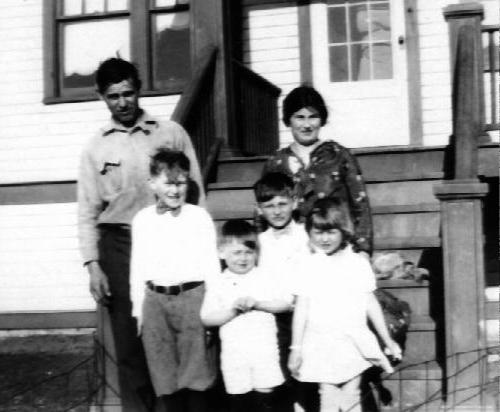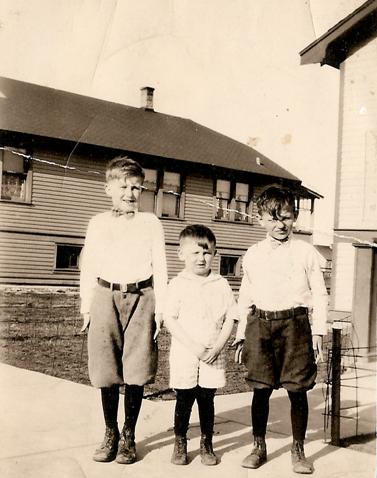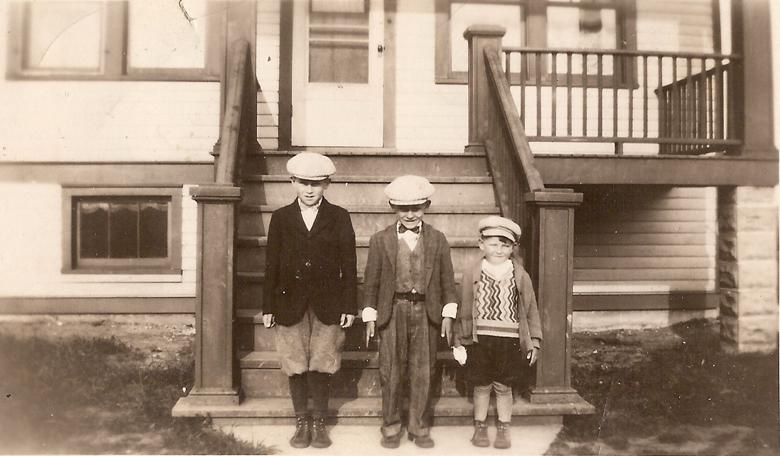
All of these photos were taken at 4425 South Wenonah Avenue in Stickney, IL.
In photo at Right are: Phil, Ed and John. In photo below are: Phil, John and Ed.


|
I'm not certain of the year, probably 1927 or 1928, when Dad began earning rather large sums of money in his job at the brickyard. It was a time when everyone who worked seemed to be doing the same, the so-called "good times." This increased earning capacity for many led to changes in lifestyles. We who were once near to the poverty level were now experiencing an independence previously thought of as an impossibility. Mom and Dad were able to put some of Dad's earnings aside in the hope of one day buying their own home.
|
John ('Jack') and Mary Sedory, with (Left to Right): Philip, Edward, John and Marie. All of these photos were taken at 4425 South Wenonah Avenue in Stickney, IL. In photo at Right are: Phil, Ed and John. In photo below are: Phil, John and Ed. |  | ||
 | |||
Prohibition and Crime Since alcoholic beverages had been banned when the Prohibition Law [that is, the National Prohibition Act] was passed, and the Fed's were hard at work trying to enforce it, the demand for whiskey grew more and more as time passed. So one way to try skirting around bringing it over state lines where it was more readily available was to produce it locally among residents who would less likely be suspect. I don't know how many people in Stickney got involved, but it had to be many—one of our next door neighbors, for example, joined that group.
Vacant land separated our new house and Harlem Avenue to the west, just one or two half blocks away. Al Capone often operated from a speakeasy located almost due west of our house and on the east side of Harlem Avenue[2]. The building housing the speakeasy was a few stories high, having a small window located just under the roof level and on the back side facing our house. Many times had we seen some sort of signaling with blinking lights. We'd heard the police department in town cooperated with the mob, and most likely advance warning was given when a "bust" was about to take place. Folks who lived in that area, for the most part, knew Al Capone and thought he was OK. Money "talked" then as much as it does today.
For those of you who were not around at the time of The Great Depression and have not read or heard about it, you may not appreciate what it was like to have lived though those years. The "New House" in Stickney compared with others we had lived in was almost the ultimate in contrast. Brand new, running water, inside toilets, paved streets, neighbors all over the place, bus transportation a couple blocks away, all these and more made adjusting upward almost as difficult as going in the opposite direction. But I suppose it's kind of like the guy who said, "I've been rich, and I've been poor; rich is better!" So it must have been easier to go in this direction. That Depression was close at hand, but it was still in the future. Early Unpleasant ExperiencesIn the couple of years or less that we were in this new house, I personally experienced both pleasant and unpleasant times. So having more didn't make everything perfect, for me at least. One of the unpleasant times lasted during my entire first year at the Haley Elementary School[3]. It was one of those ordeals I'd just as soon not include in this life's story, but to leave it out wouldn't be doing justice to truth.
A couple of major events took place in those two years or so (maybe less), one of which had its setting on a snowy, wintry day: After I left for school that day, a snow storm began depositing vast amounts of snow which, when coupled with existing strong winds, drifted into extremely difficult, if not impossible, heights for a six year old to handle. But being a boy in every sense when it came to challenges, I eagerly headed for home when school let out. It was not a wise decision.
Christmas, 1928Perhaps the last major event I can recall while still living the abundant life was the Christmas of 1928. We had enough financial reserve now to ask for things which in the past we couldn't even have wished for, and just before that Christmas we boys had all asked for musical instruments. Naturally, we went the route of putting in our request to Santa Claus, but deeply within our hearts I don't think we really bought that concept as the real source of those gifts. But not wanting to upset the apple cart, so to speak, and not being absolutely certain of this character, Santa Claus, we went along with the game. And, by the way, when I said "we had enough financial reserve," I was referring to my folk's finances, not ours as kids. Most likely our sister Marie had wished for and received a doll that Christmas, while we boys got the musical instruments each had requested. I'm sure we were delighted, maybe even ecstatic, in receiving everything asked for right down to the letter. I'm sure those weren't the only gifts we received, either. Destructive Little Minds Well, it was just a matter of time until our inquisitive little minds (emphasis on "little") conceived the idea of investigating the origin of the sounds which came from these instruments. And disassembly in a most unprofessional manner was begun. A knife was inserted into both the drum and the accordion, but nothing "mysterious" was found in either which would have shown what produced those sounds. Whatever the third instrument was, I'm certain it received about the same kind of treatment in this research project.
Well, that was near to the end of Christmas, birthday, and general extravagances in which there had been plenty. The big bucks kept coming in, but gradually it was discerned that more and more money was needed to buy everything. Rapid inflation soon brought people to the realization their dollar had little value.[4] The big earnings no longer kept pace with the decline in the value of the dollar, and it wasn't long before many could no longer meet mortgage payment requirements[5]. The handwriting was on the wall. The good life experiences were over. Radical changes in lifestyle would be required of almost everyone. | ||||
Footnotes 1[Return to Text] We know this because the Proceedings of the Board of Trustees of The Sanitary District of Chicago recorded the rental payments of John Sedory, Sr. throughout 1927 and 1928, up to and including April, 1928 on page 1325, 2nd to last entry in the 1928 Proceedings of the Board of Trustees of The Sanitary District of Chicago. After that month, he isn't mentioned again until 1930 (see next chapter). 2[Return to Text] One source states there was a "Capone joint" called the "Harlem Nut House" at 4232 S. Harlem Ave., Stickney, IL. If this was the location of the 'speakeasy' our author is describing, they may have been able to see farther if there were fewer houses back then. (Note: The current building at 4232 S. Harlem Avenue is a new condo; in fact all the buildings up and down the street appear to be of fairly recent construction. If anyone has a picture of this street from that era, it might be helpful in resolving this question.) On the other hand, a different source states that Ralph Capone (Al's brother) operated: "a 'dime-a-dance' joint in Stickney, Ill, on Harlem Ave., called 'Dreamland'." So perhaps this was located further south in the 4400 block. 3[Return to
Text] Haley School, named for Augustus Haley, the third superintendent of Lyons School District 103, was built in 1923 [Pioneers of Progress ... the history of Stickney Township (Stickney Township Office, 1969), pp. 25, 29.] on the southeast corner of 40th Street and Grove Avenue (to the alley), continuing almost all the way to 41st Street; the building survived until 1987 when it was demolished by School District 103. The land was later sold to the Village of Stickney, and converted into Haley Park in 1989. (Faith Community Reformed Church is just east of the park, across the alley, on 40th Street.) 4[Return to Text] Which has happened a few times again since the end of the 1920s, not to mention the fact that our own government continues increasing its 'hidden tax' on anyone who has money in the bank by constantly printing more money and devaluing what we worked so hard to earn and save as we were told to! We all should have bought gold or something else they couldn't ruin like that. And if all countries decide to stop using American dollars as the "World's Reserve Currency," it may decrease in value by 30% or more overnight! (Perhaps this section title applies equally well to those politicians doing this?) 5[Return to Text] To clarify: Mortgage payments were not the problem, since they are generally a set rate for many years (unless one unwisely signed a contract stating the payments could be increased), but rather the inflationary costs of goods and services, such as food, water, fuel, etc. (and today, taxes too!) which meant that many had too little money left to pay the mortgage, or not enough to eat, because their wages did not increase along with the inflation. | ||||